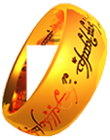Things of Middle-earth
Grond – First Age
Type: Weapons
Meaning: Club
Other Names:
the hammer of Angband
the hammer of the underworld
Description:
The great war mace 1 wielded by Morgoth in his duel with Fingolfin, the High King of the Noldor, outside Angband in the First Age:
Morgoth fought with a great hammer, Grond, that he wielded as a mace, and Fingolfin fought with Ringil. Swift was Fingolfin, and avoiding the strokes of Grond, so that Morgoth smote only the ground (and at each blow a great pit was made).... But wearied at last Fingolfin fell, beaten to the earth by the hammer of Angband, and Morgoth set his foot upon his neck and crushed him.
In his last throe Fingolfin pinned the foot of his Enemy to the earth with Ringil, and the black blood gushed forth and filled the pits of Grond. Morgoth went ever halt thereafter.
The War of the Jewels, HoME Vol 11, Part 1, The Grey Annals
Then Morgoth hurled aloft Grond, the Hammer of the Underworld, and swung it down like a bolt of thunder. But Fingolfin sprang aside, and Grond rent a mighty pit in the earth, whence smoke and fire darted. Many times Morgoth essayed to smite him, and each time Fingolfin leaped away, as a lightning shoots from under a dark cloud....
But at the last the King grew weary.... Thrice he was crushed to his knees, and thrice arose again and bore up his broken shield and stricken helm. But the earth was all rent and pitted about him, and he stumbled and fell backward before the feet of Morgoth; and Morgoth set his left foot upon his neck, and the weight of it was like a fallen hill. Yet with his last and desperate stroke Fingolfin hewed the foot with Ringil, and the blood gushed forth black and smoking and filled the pits of Grond.
The Silmarillion, Quenta Silmarillion, Ch 18, Of the Ruin of Beleriand and the Fall of Fingolfin
Black-armoured, towering, iron-crowned
he issued forth; his mighty shield
a vast unblazoned sable field
with shadow like a thundercloud;
and o'er the gleaming king it bowed,
as huge aloft like mace he hurled
that hammer of the underworld,
Grond. Clanging to ground it tumbled
down like a thunder-bolt, and crumbled
the rocks beneath it; smoke up-started,
a pit yawned, and a fire darted....
Thrice was Fingolfin with great blows
to his knees beaten, thrice he rose
still leaping up beneath the cloud
aloft to hold star-shining, proud,
his stricken shield, his sundered helm,
that dark nor might could overwhelm
till all the earth was burst and rent
in pits about him. He was spent.
The Lays of Beleriand, HoME Vol 3, Ch 3, The Lay of Leithian, Canto 12, Lines 3562-72, 3591-98
Etymology
RUD- *rundā: Q runda rough piece of wood; ON runda, N grond club; cf. Grond name of Melko's mace, and name Celebrond 'Silver-mace'.
The Lost Road and Other Writings, HoME Vol 5, Part 3, The Etymologies
Notes
1 A mace is a simple weapon... that uses a heavy head on the end of a handle to deliver powerful blows. A development of the club, a mace differs from a hammer in that the head of a mace is radially symmetric so that a blow can be delivered equally effectively with any side of the head. A mace consists of a strong, heavy, wooden or metal shaft, often reinforced with metal, featuring a head made of stone, copper, bronze, iron, or steel.
The head can be shaped with flanges or knobs to allow greater penetration of armour. The length of maces can vary considerably. The maces of foot soldiers were usually quite short (two or three feet, or 70 to 90 cm). The maces of cavalrymen were longer and better designed for blows from horseback. Two-handed maces could be even larger.
"Mace (club)". Wikipedia, the free encyclopedia. 7 Sep. 2010.
<Wikipedia.org en.wikipedia.org/wiki/Mace_%28club%29>.
Contributors:
Dim Genesis, 6Jun03
Lyllyn 6Dec04
Elena Tiriel 6Sep10

